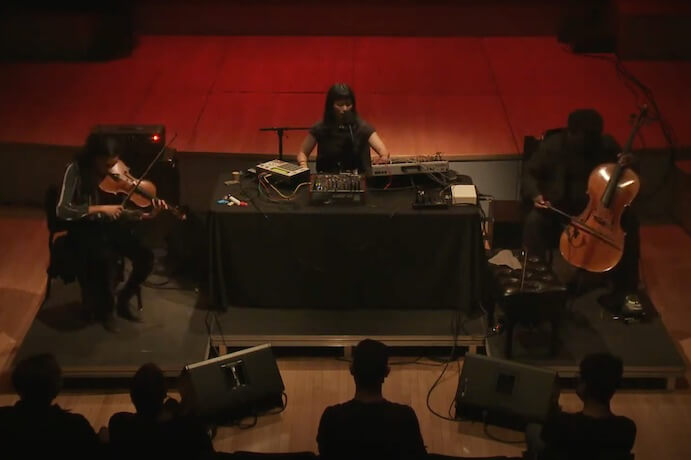There’s a weirdly reflexive magnetism between New Zealanders who live overseas. I think we find comfort in the familiarity of other Kiwis, and maybe because there aren’t that many of us, we tend to extend that warmth and openness to Australians far from home. I had been sick (not, I should add, with anything contagious) and hadn’t left my apartment for days before the October 27 show featuring Australian vocalist and improviser Charmaine Lee at Roulette, but I hopped on the G train (with nausea and brain zaps) because Roulette has that same draw for me, and I was excited to see a fellow Antipodean doing very cool things in New York.
Founded and led by Jim Staley, Roulette is a rare institution where artists are truly invited to experiment and take risks. In her improvisatory performance in two halves, Charmaine Lee did just that. She fractured her voice into static and ribbons of feedback that she deftly controlled with a mixing desk and modular synthesiser. Her improvisation was a warm bath with a current of electricity running through it: her sound-fields inviting, encompassing, and electrocuting the listener.

Lee studied jazz voice at the New England Conservatory before she discovered her calling in improvisation. Her style draws on the body of work developed by artists like Pamela Z and Meredith Monk, with percussive utterances and syllabic expression absent of explicit meaning or denotation. At the top of the show, Lee greeted the audience in her sunny Australian accent and then proceeded to bind her neck with a strip of fabric before carefully slipping a microphone beneath it, pressing it against her throat. Her 30-minute solo improvisation was a visceral swooping and glitching between digital and analog sounds, between pulsing and pulseless states.
Ordinarily undesirable noises like the bumping of a microphone were synthesized into curiously rich textures, juxtaposed with spasms of swarming static that called to my mind the music of Ryoji Ikeda. Lee’s close-micing of small mouth sounds has a cousin in ASMR (I seem to be in the tiny minority of people who find ASMR unbearably unsettling). She wrested sometimes overwhelming waves of sound from sparse sources, and in parts of her improvisation, long vocal tones encased in quiet, plush pads made for moments of loveliness lifted out of the frenetic fizzes and pops. People were sitting on the edges of their seats. Lee closed the piece by gently tapping on the microphone bound to her throat in time with her pulse.

After a break, Lee returned to her desk — set up in front of the stage at the same level as the audience — with cellist Lester St. Louis and violinist Joanna Mattrey. Mirroring the digital-analog hybridity in Lee’s work, St. Louis wielded a convex baroque bow and a battle-scarred cello fitted with a pickup. He controlled his sound with the kind of volume pedal normally used by electric guitarists. Instead of a tailpiece, the cello’s strings were attached to the bottom of the instrument with wires. I couldn’t stop watching him; all three musicians had their eyes closed, and St. Louis especially seemed held in a rapturous trance, his bow whipping vertically up and down the strings and over the fine tuners and wires as he slowly detuned a string. He tossed his cello in and out of his hand, lifted it, swayed it, rubbed it, and cradled it on his lap. At one point in the improvisation, he whirled a microphone in tight circles next to his head.
Mattrey had fitted a chunk of polystyrene between the middle strings of her violin and, pressing her bow down hard, she drew a scratch tone squawk from her instrument that reminded me both of electric guitar distortion and of raucous Australian birds. Mattrey shifted her bow behind the polystyrene, and with light bow pressure, conjured the brittle, plaintive sound of an erhu. A master of invention, St. Louis fingerpicked his cello with all of his fingers on both hands, emulated the languid pizzicato of a double bass, switched between bows, and used the pinkie finger of his left hand to press his bow into the wires beneath the strings. Like St. Louis, Mattrey used demonic pizzicato and fingerpicking to create a pointillistic bristling that blended seamlessly into the lush reverb of Lee’s sonic world. Lee was poised in the centre, leading the improvisation and creating a meta-instrument with her collaborators. When the trio had finished their improvisation the audience and performers sat spellbound and quiet for a long time before breaking into applause.
I CARE IF YOU LISTEN is an editorially-independent program of the American Composers Forum, funded with generous donor and institutional support. Opinions expressed are solely those of the author and may not represent the views of ICIYL or ACF.
A gift to ACF helps support the work of ICIYL. For more on ACF, visit the “At ACF” section or composersforum.org.
























